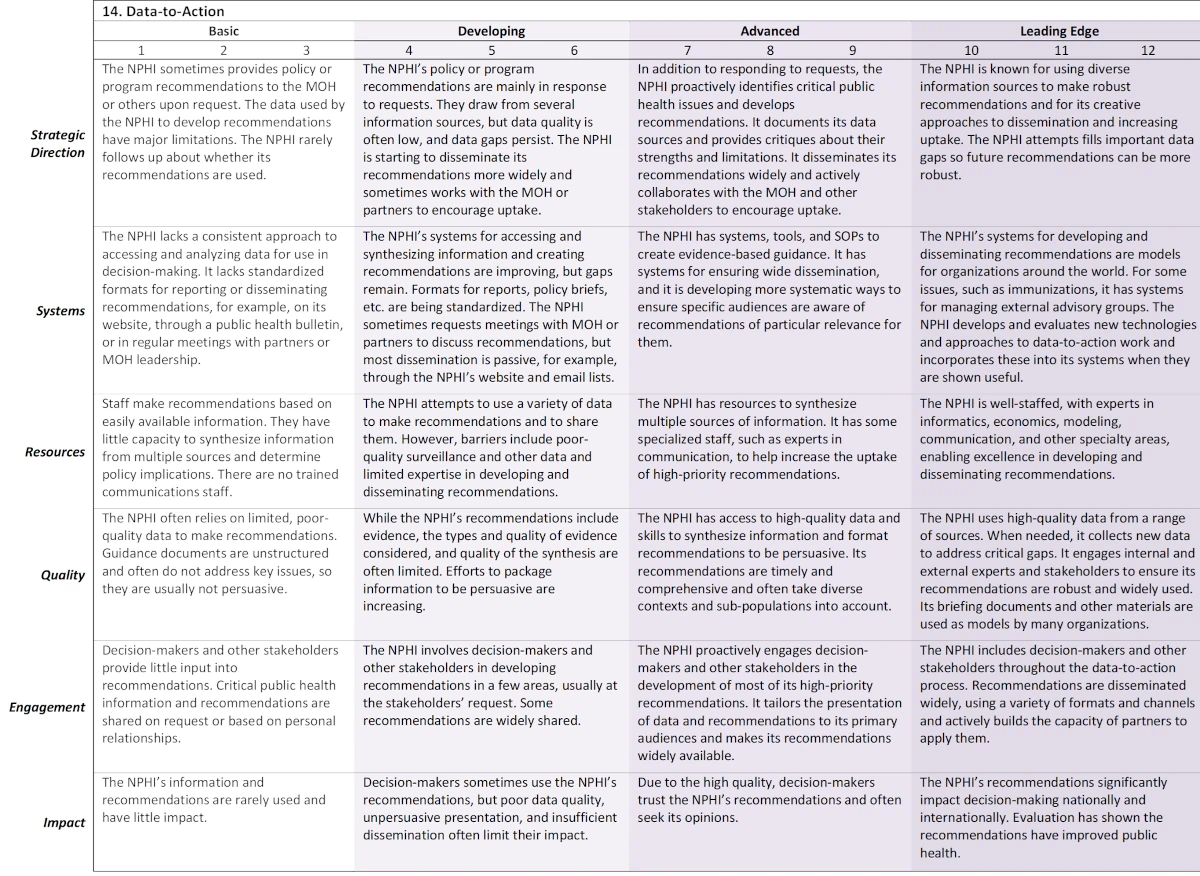Staged Development Tool
National Public Health Institutes (NPHIs) often face challenges in identifying the most critical next steps to improve their internal operations and performance of core public health functions. To fill this gap, the U.S. Centers for Disease Control and Prevention (CDC) and the International Association of National Public Health Institutes (IANPHI), in consultation with a group of NPHI leaders from around the world, developed the Staged Development Tool (SDT). The SDT helps NPHIs assess their current capacities and create plans to reach higher levels of functioning.
Staged Development Tool Overview
The Staged Development Tool was released in 2017. It has been updated several times since then, to reflect advances in technology and practice and to respond to requests from NPHIs to cover additional topics, such as noncommunicable diseases. More than 25 countries have used the SDT.
The Discussion Guides are the most widely used part of the SDT. They contain details that provide a basis for in-depth discussions about issues of high priority for NPHIs. They are based on a maturity model – the idea that for a given topic, NPHIs exhibit different levels of development. The Discussion Guide Developmental Stages range from Basic to Leading Edge.

By providing detailed examples of what these stages "look like," Discussion Guides facilitate conversations that help participants clarify their NPHI's current and desired stages and develop plans to achieve their desired stages. The SDT also includes descriptions of ways to use the Discussion Guides, details about conducting formal SDT workshops, and forms to capture the results of discussions. Most SDT materials are available in English, French, Portuguese, and Spanish. You can find more details about the SDT materials and use in the downloadable PowerPoint.
Discussion Guides
Each Discussion Guide has the same structure: four Developmental Stages (Basic, Developing, Advanced, and Leading Edge) and six domains per stage (Strategic Direction, Systems, Resources, Quality, Engagement, and Impact). The six domains are described in the "Domain Definitions" document.

Most Discussion Guides have been developed for internal use by NPHIs or by groups that will be joined together to make an NPHI. These NPHI-focused Discussion Guides are organized into two broad categories: internal-facing and external-facing. Internal-facing Discussion Guides relate to NPHI internal operations, including such topics as leadership and management, financial management, and health and safety of NPHI staff.
External-facing Discussion Guides often overlap with core public health functions, as described in the "IANPHI Framework for NPHI Development" and other internationally recognized documents. They include activities designed to impact or engage people and organizations outside of the NPHI. These include functions, such as surveillance, public health research, and emergency response. The “Generic Discussion Guide” provides a basic structure that can be adapted to address issues not covered by the other external-facing Discussion Guides, for example, unintentional injury or violence prevention.
Internal-Facing Discussion Guides
- Organizational Leadership and Management
- Human Resources (HR) Management
- Financial Management
- Information Technology (IT) and Management of Organizational Information
- Health and Safety
- Laboratory Safety
- Internal Communication
- External Communication About the NPHI and Its Activities
External-Facing Discussion Guides
- Population Health Status
- Health Communication and Promotion
- Laboratory Systems
- Surveillance
- Emergency Preparedness and Response (EPR)
- Data-to-Action
- Public Health Workforce (WF) Development
- Public Health Research
- Multisectoral Collaboration
- Linkages with Subnational Public Health
- Noncommunicable Diseases
- Generic Discussion Guide
Use the "Choosing a Discussion Guide" document for ideas about how to select a Discussion Guide that best fits your needs. If you wish to obtain an editable version of a Discussion Guide, please contact info@ianphi.org.
Using the Discussion Guides
Discussion Guides have proven useful for enhancing communication among groups that are working to achieve shared goals and for planning. Processes using the Discussion Guides help participants
- Increase understanding of each other’s work
- Support neutral discussions about difficult issues
- Imagine a future that include activities and accomplishments not previously considered
- Identify shared visions and priorities
- Develop specific action plans for how to move to a higher stage
The Discussion Guides can be used in different ways. Several NPHIs have conducted formal workshops, using multiple Discussion Guides in formal workshops over several days for long-term planning, as described below.
Discussion Guides can also be used with less structured approaches. For example, groups within NPHIs, such as teams or branches, have used them in settings such as staff meetings to identify gaps and ways to address them. NPHIs sometimes use them to help build closer ties between teams with shared goals, for example, to help laboratory and epidemiology teams improve use of laboratory data for surveillance.
NPHIs have also used Discussion Guides with external partners, to explore ways to build national capacity. Three Discussion Guides that have been modified for NPHIs to use with external organizations can also be found in the table, covering the topics: Coalitions, Noncommunicable Diseases, and Workforce Development. An adapted version of the SDT is a component of the Noncommunicable Diseases Capacity Assessment and Planning (N-CAP) Process. View more details about the Noncommunicable Diseases Capacity Assessment and Planning Process.
IANPHI and U.S. CDC encourage NPHIs to be creative and flexible in their use of Discussion Guides. However, NPHIs are also urged to consider implementing the complete SDT workshop process when robust planning is needed and resources are available.
See also:
Staged Development Tool Case Study: Colombia Instituto de Salud: Implementation and Outcomes
Use of the Staged Development Tool for Assessing, Planning, and Measuring Progress in the Development of National Public Health Institutes, published in Health Security, Volume: 16, Issue S1: November 27, 2018
Addressing emerging public health threats: the Noncommunicable Disease Capacity Assessment and Planning (N-CAP) Process, published in Frontiers of Public Health, Volume: 12: 2024.
SDT Workshops
SDT workshops are facilitated sessions that result in concrete plans to help the NPHI move to a higher stage of development. These facilitated workshops are typically held by an NPHI, bringing together leaders of groups that need to work together to elevate the developmental stage of the NPHI.
The number of Discussion Guides covered depends on factors such as the purpose of the workshop (more Discussion Guides would be used for overall strategic planning than to address a specific topic) and logistics. Often, the workshops cover a mix of internal- and external-facing topics. U.S. CDC and IANPHI staff may be available to help an NPHI plan a workshop.
An SDT workshop involves three steps:

Step 1: Assess
NPHIs use Discussion Guides that are most relevant to them to assess their current and desired stages and the reasons they have not reached the desired stage. The concrete examples of NPHI capacities in the four maturity stages provide a basis for in-depth conversations.

Step 2: Prioritize
The next step is to select the highest priorities for planning. During the discussion of priorities, the facilitator probes participants to ensure that the priorities and plans will address the root causes inhibiting progress.

Step 3: Plan
Once the NPHI has identified its priorities, planning can begin. Detailed plans, including who will be responsible and timelines, are recorded. In addition, the participants discuss easy wins – impactful activities that can be accomplished easily and will build momentum.

Forms to Capture SDT Discussions
Two fillable forms have been developed for use with the SDT: the Assessment Form and the Next Steps Form. These are most often used as part of an SDT workshop, but they may also be helpful for capturing ideas during less formal conversations based on the Discussion Guides.
SDT Assessment Form
The Assessment Form is used to capture the key points from discussions during Assessment. It includes spaces to record current and desired scores and reasons why those scores were selected. It is used to record ideas about the underlying reasons the NPHI has not yet achieved the desired stage or score.
SDT Next Steps Form
The Next Steps Form is used to set priorities and record the next steps for the NPHI to move to a higher stage. It has space to identify who is responsible for implementing the next steps and the timelines.
For Further Information
Assistance may be available for individuals or teams seeking to
- Use the Discussion Guides or hold SDT workshops
- Modify Discussion Guides to meet specific needs
- Gain insights into facilitation and other techniques for optimizing use of Discussion Guides
If you have any comments or questions or would like to request assistance with using the SDT, contact IANPHI at info@ianphi.org or the U.S. CDC's NPHI Program at NPHIProgram@cdc.gov.